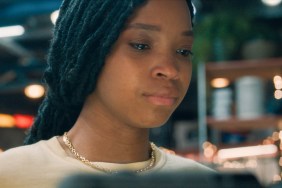Today saw the launch of the Sanctum 3D Mobile Experience, a traveling theater that will showcase scenes from the upcoming film for free across a dozen US cities over the next four weeks. To launch the event, director Alister Grierson joined executive producer James Cameron and writer/producer Andrew Wright for a discussion about the film, the true story behind it and how, in a way, the 3D element plays a larger role in Sanctum than it did in Avatar.
Inspired by the real-life experiences of Wright, the thriller came after a near-fatal storm that hit when the explorer was cave-diving in Western Australia’s Nullabor Plain.
“We were exploring an underwater cave system similar to what we’ve got in ‘Sanctum,'” Wright recalls, “On the last day of the expedition, we were hauling all of our equipment out and most of the people in the cave were engaged in that activity. I was on quite a small ledge hauling tanks up and a freak storm hit the area. What started as a trickle of water from the cave… turned into a torrent which then started to collapse the entrance to the cave. Literally, boulders the size of an SUV were rolling down in the cave. You could hear the clatter of scuba tanks banging off the walls. It trapped about fifteen of us below ground.”
Luckily for Wright, he survived the incident and, after working with Cameron on his 3D documentaries, decided to script a thriller based on the same scenario. Produced in Australia for a modest budget, Sanctum aims to apply the same cameras used in Avatar to different effect. By telling a story of incredibly close-quarters, the upcoming film is able to make more distinctive use of the technology.
“‘Avatar’ had so many wide vistas,” explains Cameron, “that the difference between watching the movie in 2D and 3D is not that great. The more expansive the image, the less you feel in close contact with the characters or objects. It’s the intimate scenes in ‘Avatar’… that were really the most effective.”
For Sanctum, intimacy is driven to a terrifying level as the characters squeeze through dark, flooded caves in search of some kind of an exit. To achieve the cramped, underwater shooting, the cast was required to undergo extensive training with Grierson joking that they waited for the most dangerous stuff until the last day of shooting.
“The problem was that half the schedule was things that should have been shot on the last day,” laughs Cameron.
Following the presentation, Grierson spoke exclusively with ComingSoon.net about the film and working under such unique conditions.
ComingSoon.net: When did you and James Cameron first meet and how soon this project come your way?
Alister Grierson: Well, I made a movie in 2006 called “Kokoda.” It was a low-budget Australian war movie, a period movie, set in Papua New Guinea in World War II, in 1941. It was a very successful movie in Australia. It was commercially successful and critically very successful, but it was never released in America for the usual reasons. Andrew Wight, the producer of the film, had seen “Kokoda” and liked a lot of elements in it and thought there was a similar connection to “Sanctum” in terms of some of the scenes, which is essentially about people under stress in a harsh environment. There was something about “Kokoda” and it’s tone as well that I think really appealed to him. Real people in very real and recognizable environments. He got the film to Jim and Jim watched it and he liked it and obviously saw something in there that he thought matched “Sanctum.” He flew me across to Wellington where he was shooting “Avatar.” We spent a week together and I brought my cinematographer with me so we could spend some time with him going through his process in terms of the way his cameras work and the systems they were using. Now his film was very different, of course, because a large part of it was the motion capture element. He was shooting with a virtual camera and there were real-time CGI elements. His was a very high-tech environment for making “Avatar” whereas ours is 100 percent live action. But nevertheless, we’re using the same kind of cameras so there’s a similar kind of work flow and a lot of stuff for us to learn. By the end of the week, I think we all agreed that we would be the team to do it. But that was a ways back now. Two and half years ago or something.
CS: James Cameron joked that if you were going to make a movie for him, you were doing it in 3D. I imagine anyone would jump at the chance, but was there any apprehension about the technology?
Grierson: Not at all. It’s just so exciting when you see the technology working and all the potential of it. You want to be creative with the access to this tool you use if you can. When I was in Wellington, I saw a short film that Andrew and Jim had made together. It was a ten-minute underwater diving movie that they have made at a place called Ginnie Springs in Florida. It was essentially a sort of pitching document to the studios and as soon as I saw that, I was hooked. Underwater just looks fantastic in 3D. it really captures the experience. Cave diving was part of my training for this film. In fact, they put me in a cave on day three of my scuba diving course, which was a bit confining. The amazing thing was how similar it is watching 3D and being in the water in a cave. It’s really uncanny. Of course, I’d seen other films that they had made together, “Ghosts of the Abyss” and “Aliens of the Deep,” where they’re using the 3D underwater. The difference is that we used two cameras while making this movie. One is called a fusion camera. It’s a Pace Fusion camera. It involves a vertical camera and a horizontal camera shooting from a mirror. It give you a lot more control over how you capture the 3D. But our underwater camera is what’s called a “side by side” rig. It’s pretty much the same camera that Jim and Andrew used in “Aliens of the Deep” and the result is really stunning.

CS: Usually when you cast actors for movement, you see them perform as part of the audition. Was there a point where the auditions moved into a swimming pool?
Grierson: It was definitely contractually that the actors had to be able to pass a fitness test and all the training courses before they could do it. So we cast and then got them into the training, but we did have a sort of clause that said that, if they couldn’t do it, they wouldn’t be able to do the movie. It was such an important thing for me that the actors were able to do their own stunts. When you see the result, they’re really quite stunning. These are actors using very technical equipment. We’ve got them in these narrow squeezes underwater seven meters deep. They’re pushing their rebreathers through these squeezers and it’s really the actors doing it. You see the actors doing it. That really, in my mind, makes the story much more compelling because you’re never cutting to the stuntman who’s doing the 50 meter leap where you know, “That’s not Paul Newman doing that. That’s some young, idiotic 20 year old jumping off a cliff.” This is the actors actually doing the real thing with all their own jumps and leaps and a lot of physical stunts. You’ve got a lot of safety people supervising things and they’re obviously trained by the stunt department. We often use the stunt doubles when we’re shooting or setting up shots. We’ll shoot the stuntmen doing the stunts as well just because it gives you extra footage, but as much as I can, I like to use the actors. That’s really important to me because I think it helps the story.
CS: You’re filming with some very technical equipment. Did you have much background with such heavy hands-on filmmaking?
Grierson: No, I never dived before but it really was the most fun of the whole shoot. My cameraman and my key photographer and I all got together the first time and we dived a huge tank at the studio. We built one of the major set pieces, basically an underwater labyrinth. Then we had to build a ceiling out of the top. It didn’t cover the whole pool so we had to shoot at nighttime. Each day we could probably only do about a minute’s worth of material that would ultimately end up in the film. If you’re shooting for 12 hours, you’re usually only catching about a minute’s worth if you’re lucky. Sometimes it’s just 40 seconds. Then we also had a scale model of the set that was quite huge. It was about an eight foot by six foot scale model of the set and we could take a look at that to see what we needed to do for the day. Then our cinematographer could block through with his electrics guys and where he needed them to be. Then we’d go to the car park and block out with the camera and all the special effects guys. And then we’d go to dinner, actually, and start shooting right after. We’d come back and get everything cued up in the wetsuits and so on. Then we’d shoot through the night till about three o’clock in the morning. We did that for about four weeks. It was a lot of fun. It was really strange because I would be outside the tank with my cinematographer and we would communicate with everyone underwater. It’s very laborious work, but it’s also a lot of fun. It’s very satisfying. You’ve got to learn, in cinema, to deal with stories as just pictures alone.
CS: There’s obviously a lot of old-school James Cameron elements at play in “Sanctum.” Is that something that grew out of homage or do you just see eye-to-eye as storytellers through those elements?
Grierson: Well, in preparation for this I obviously watched all of Jim’s movies. To be honest, I can see the connection with Jim there, but I think when you see the whole thing you’ll find that it has a really unique voice and a very strong voice. But clearly when you’re dealing with water and all the technology on-set, you’re working in common themes of all the stuff that Jim’s done. Again, he’s not so interested in exploring the technology. It’s the people and it’s the drama and relationships. How we tell the story. The bond between the father and son character, for example. Jim, I think, has been misread in a lot of ways just because he’s played up the high-end of technology. I don’t think he’s necessarily interested in technology. He’s interested in stories, you know? You go out there and you try to capture a lot of material, but then the real key is cutting it down and getting rid of the excess baggage. That’s Jim’s real strength. He’s a consummate storyteller. I watched “Avatar” on the airplane a couple of months ago. It’s a long movie. It’s like two and half hours or something, but I was watching and realizing that it’s really lean. It really is. You look at his storytelling prowess and that was the biggest influence for me. It all comes back to story. There’s a lot of humanity in filmmaking. You can have a beautiful technical shot that took all day to capture and then you love it in the editing suite because it’s so flawless, but you may find you’re holding onto it for all the wrong reasons. Sometimes you need someone like Jim to come along and say, “That’s beautiful, but you don’t need it. Trust me, the story’s going to be better if you get rid of that stuff.”
Sanctum hits 3D, 2D and IMAX 3D theaters on February 4th. More details on the 3D Mobile Experience are available on the film’s Facebook page.









